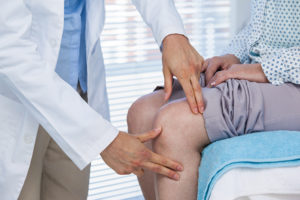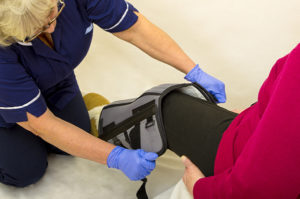Would I be less likely to get osteoarthritis if I wasn’t active when I was younger?
I have 70- year olds as patients who have run their whole lives and their knees look normal, and I have 45-year olds who aren’t active, and their knees are very arthritic.
What are the signs of osteoarthritis that we shouldn’t ignore?
It is not unusual to get areas of inflammation around a joint or a little cartilage irritation after a big day of Christmas shopping, for instance. Or maybe your knee became a little sore, and you’re limping a bit, the day after you go to the amusement park with your grandkids. These are common inflammation-type episodes and usually resolve; they’re self-limiting.
 But, don’t ignore swelling in a joint, particularly if it isn’t going down after a few days, because it’s a sign that something inside the joint is unhappy. And, pain that starts to interrupt your daily living, such as when you’re getting in and out of a car, walking up and down steps, or waking you up at night when you roll over, should be checked out by your healthcare provider.
But, don’t ignore swelling in a joint, particularly if it isn’t going down after a few days, because it’s a sign that something inside the joint is unhappy. And, pain that starts to interrupt your daily living, such as when you’re getting in and out of a car, walking up and down steps, or waking you up at night when you roll over, should be checked out by your healthcare provider.
Arthritis in the beginning waxes and wanes; you have good and bad days, but if you have repeated episodes, then look into it. Osteoarthritis progresses quickly in some people and over years for others. A knee twinge today can turn into a weekly knee twinge in a year, perhaps swelling after a tennis match.
Which is more prevalent, knee or hip osteoarthritis?
Knee osteoarthritis is a little more common than hip osteoarthritis, not quite two to one. The knee is a bigger joint than the hip and has a little more complex motion to it.
What can we do, after we turn 55 years old, to minimize our risk of getting osteoarthritis?
 Unfortunately, no activity will guarantee that your joints stay healthy, and no activity guarantees you’ll eventually require joint replacement because you were too hard on your joints. Injury is the big issue! Some of the things you can do in your favor include staying active. Many underestimate the value of walking as an exercise, which builds great endurance against gravity and builds great core strength. Walk a couple of times a day, 30 minutes each time. Your pace doesn’t have to be fast, but it should be more than a stroll.
Unfortunately, no activity will guarantee that your joints stay healthy, and no activity guarantees you’ll eventually require joint replacement because you were too hard on your joints. Injury is the big issue! Some of the things you can do in your favor include staying active. Many underestimate the value of walking as an exercise, which builds great endurance against gravity and builds great core strength. Walk a couple of times a day, 30 minutes each time. Your pace doesn’t have to be fast, but it should be more than a stroll.
As you stiffen up with age, moving is good for the cartilage in your joints, for your flexibility. Gentle, hip and knee friendly, stretching type exercises will ensure that you work your joints to their full range of motion. And, since we all lose strength as we age, it’s important to maintain a healthy body weight. Even 10 pounds of weight gain can increase your chances of getting osteoarthritis by one-third!
Once you start to experience symptoms, what can you do to slow the progression of osteoarthritis, and avoid surgery?
 Early interventions don’t really stop the progression of the disease, but manage the symptoms, which are affecting the quality of your life at the end of the day, putting your life ‘on pause,’ slowing you down, making you make concessions in your activities. These include anti inflammatory medications, a variety of injections, physical therapy and braces that can be helpful for some activities. As an orthopedic surgeon I like to be involved in the process of the treatment, not just come in at end of the road, when we’re going to talk about surgery.
Early interventions don’t really stop the progression of the disease, but manage the symptoms, which are affecting the quality of your life at the end of the day, putting your life ‘on pause,’ slowing you down, making you make concessions in your activities. These include anti inflammatory medications, a variety of injections, physical therapy and braces that can be helpful for some activities. As an orthopedic surgeon I like to be involved in the process of the treatment, not just come in at end of the road, when we’re going to talk about surgery.
Many people are afraid to see a doctor because they’ll learn something bad. A woman might wait until her hairdresser or someone at the mall sees her limping and tells her to look into it. It’s a motivator to hear from someone who was helped.


